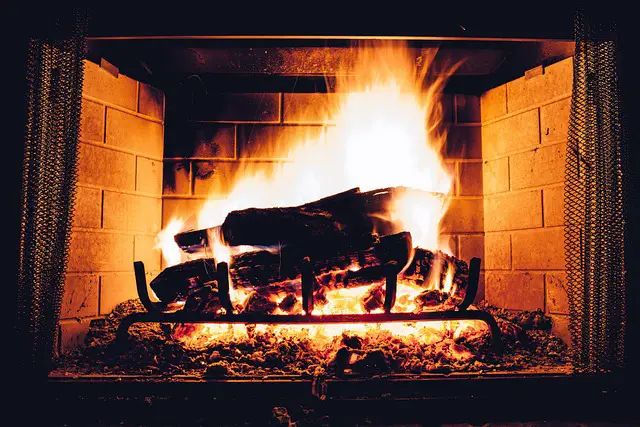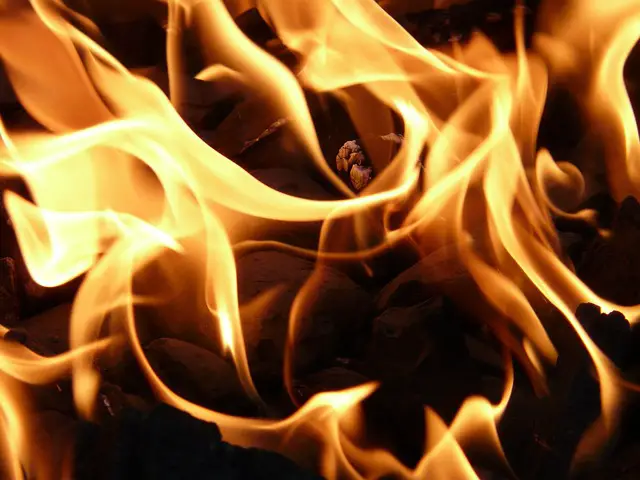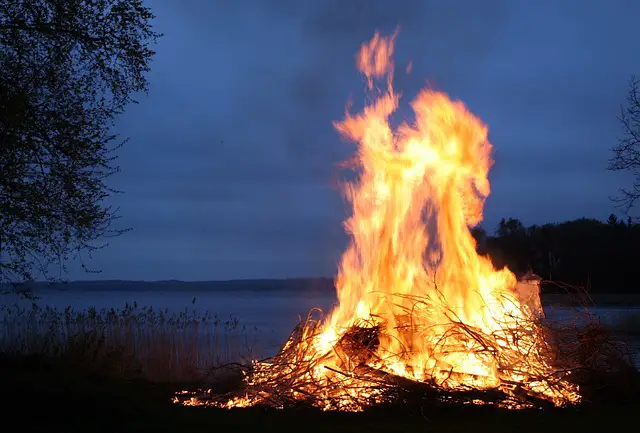A flame is the visible, gaseous part of a fire, while fire encompasses the entire combustion process, including flames, heat, and combustion products.
What Is Fire?

Fire, in its essence, refers to the chemical reaction known as combustion. It occurs when heat, fuel, and oxygen combine in a process called the fire triangle. The reaction releases light, heat, and various gases, leading to the characteristic flames. Fire is an essential element that has played a significant role in human progress.
Definition of Fire
Fire, also known as combustion, is the process of rapid oxidation that results in the release of heat, light, and various forms of energy. It occurs when a combustible substance combines with oxygen and reaches its ignition temperature, which typically ranges from 300-600 degrees Celsius (572-1112 degrees Fahrenheit). Once ignited, fire spreads by transferring heat to nearby materials that are capable of burning, causing them to release flammable gases or ignite.
Fires are categorized based on the type of fuel involved in the burning process. There are three common classes of fires, namely class A fires, which involve ordinary combustible materials like wood or paper; class B fires, which involve flammable liquids or gases; and class C fires, which are electrical fires.
Understanding the definition of fire is crucial as it enables us to recognize its characteristics and take appropriate safety precautions. By comprehending how fire is formed and how it behaves, individuals can effectively prevent and control fires, thereby safeguarding lives and property.
It is worth mentioning that fire holds great significance in human civilization. It serves as an essential tool by providing warmth, light, and the means to cook food. However, when left uncontrolled, fire can lead to extensive destruction and loss.
How Fire is Formed
Fire formation is a natural process called combustion. The occurrence of combustion requires the presence of three essential elements: fuel, heat, and oxygen. When these elements combine in the correct proportions, a chemical reaction occurs, resulting in the release of both heat and light energy. Fuel can take various forms, such as wood, gas, or oil, and acts as the substance that undergoes the chemical reaction. Heat acts as the source of ignition that initiates the combustion process. Oxygen, which is abundantly available in the air, supports the reaction by combining with the fuel and producing heat, as well as various byproducts of combustion.
The process of fire formation commences when the fuel is heated to its ignition temperature. This causes the molecules of the fuel to break down and interact with oxygen in the air, creating new molecules like carbon dioxide, water vapor, and other gases. As these reactions occur, heat is emitted, which further sustains the combustion process. The heat produced has the potential to raise the surrounding fuel sources to their ignition temperature, allowing the fire to propagate and spread.
Understanding the process of fire formation is vital for ensuring fire safety and prevention. By controlling the availability of fuel sources, regulating heat sources, and limiting the supply of oxygen, the risk of unintentional fires can be minimized. Knowledge of how fire is formed enables firefighters to effectively extinguish fires by targeting these elements and eliminating their presence.
What Are Flames?

Flames are the visible, luminous, and often flickering parts of a fire. They are the result of specific gases and particles undergoing combustion in an environment with adequate oxygen supply. Flames vary in appearance and color depending on the substances being burned.
Definition of Flames
- Flames can be defined as the visible, gaseous part of a fire.
- Flames refer to the visible, gaseous part of a fire that occurs when a substance undergoes combustion and releases heat and light.
- The combustion process involves a chemical reaction between a fuel source, oxygen, and heat, resulting in the formation of flames.
- The heat causes the fuel to vaporize and break down into volatile gases, which then combine with oxygen to ignite and produce flames.
- Composed primarily of hot gases, such as carbon dioxide, water vapor, and nitrogen, flames can vary in color depending on the fuel source and temperature.
- For instance, a blue flame indicates a high temperature, while a yellow flame indicates a lower temperature.
- Flames have a distinctive structure and consist of a base known as the “combustion zone” and a tip known as the “flame front.”
- Due to the turbulence caused by the release of heat and gases, flames exhibit a flickering and dancing motion.
- The intensity of the heat produced by flames can differ based on the fuel source and the efficiency of the combustion process.
How Flames are Produced
Flames are produced through a process known as combustion, which involves the rapid reaction of a fuel source with oxygen in the presence of heat. Understanding how flames are produced is crucial for fire safety and controlling fire hazards. By comprehending the conditions necessary for flames to form, we can minimize risks and ensure the safe use of fire in various practical applications.
To produce flames, several key steps must occur. Firstly, a flammable material, such as wood, gas, or oil, acts as the fuel source for the flame. This fuel source needs to be ignited through various methods, such as a spark, heat, or a flame.
Once the ignition occurs, heat is generated. This heat energy is essential for sustaining and propagating the flame. Additionally, the presence of oxygen is crucial for combustion to take place. Oxygen molecules from the surrounding air combine with the fuel to produce energy in the form of light and heat.
The fuel and oxygen molecules then chemically react, releasing energy in the form of heat and light. This reaction is the essence of the flame. As the heat vaporizes the fuel, it rises upwards due to convection currents, leading to the formation of the flame. The hot gases and particles emit light, creating the visible flame.
For the flame to continue burning, there must be a continuous supply of fuel, oxygen, and heat. This self-sustaining process allows the flame to persist. Knowing these processes and conditions is crucial for fire safety and minimizing risks.
What Are the Differences Between Flames and Fire?
Curious about the disparities between flames and fire? Let’s dive into the intriguing distinctions between these two captivating phenomena.
Nature and Composition
The characteristics and components of flames and fire can be understood by analyzing their nature and composition. Here is a table highlighting the differences:
| Flames | Fire |
| Nature | Combustible gas mixed with oxygen |
| Composition | Consists of ignited gases and hot particles |
| Appearance | Luminous, visible part of the combustion process |
| Color | Varies based on the type of fuel being burned |
| Structure | Irregular shape with flickering movement |
| Heat Intensity | Temperature can range from 600 to 1200 degrees Celsius |
| Combustion | Occurs when fuel, oxygen, and heat are present |
Flames embody the nature and composition of the combustion process, as they consist of combustible gases and hot particles. They exhibit an irregular shape and flickering movement due to the characteristics of the gases. The color of flames can vary depending on the type of fuel being burned. Flames are formed through the combination of fuel, oxygen, and heat in a combustion reaction.
On the other hand, fire encompasses the overall phenomenon, including flames. It represents the result of the combustion process where the fuel is ignited and self-sustains. Fire is composed of burning gases and can reach high temperatures, ranging from 600 to 1200 degrees Celsius. It is essential to note that fire necessitates the presence of fuel, oxygen, and heat.
Appearance and Color
| The appearance and color of flames | Fire |
| Flames typically appear as a visible, luminous, and flickering stream of gas | Generally invisible, as it is the heat and light emitted by the combustion process |
| Flames can have various colors depending on the substances being burned | Fire does not have a distinct color, as it is the result of the combustion process |
| Colors can range from blue (indicating a complete combustion of gases) to orange or yellow (indicating incomplete combustion) | Fire does not have a specific color associated with it |
Understanding the appearance and color of flames and fire can provide important clues about the efficiency and completeness of the combustion process. Blue flames, for example, suggest a more efficient and complete burning of fuel, while orange or yellow flames may indicate incomplete combustion, potentially releasing more pollutants into the air.
When working with fire, it is crucial to pay attention to its appearance and color to ensure safety and control. Monitoring the color and intensity of flames can help identify potential hazards such as gas leaks or improper combustion.
The appearance and color of flames and fire provide valuable insights into their nature and behavior. By understanding these characteristics, we can better comprehend the combustion process and make informed decisions regarding safety and control.
Structure and Movement
To comprehend the structure and movement of flames and fire, it is beneficial to visualize the differences through a table:
Flames Fire The visible part of the combustion process The entire combustion process along with flames Consisting of hot gases, particles, and vapors Consisting of flames, heat, gases, and solid materials Exhibiting rapid movement due to convection May or may not have visible movement Flickering, dancing, and changing shape depending on air movement Capable of spreading and propagating if fuel and oxygen are available Possessing different colors depending on the materials burning Having a consistent color or varying colors depending on conditions History has demonstrated that the study and understanding of fire and flames have played a vital role in human survival and progress. Fire was utilized by early humans for warmth, cooking, and protection. As civilizations advanced, fire found various applications such as metalworking, illuminating spaces, and even warfare. Today, fire is an essential component of our lives, driving industries, generating electricity, and powering transportation. It is imperative to comprehend the structure and movement of flames and fire to ensure safety, control, and efficient utilization of this formidable element.
Heat Intensity and Combustion
To comprehend the disparities between flames and fire, it is crucial to examine the heat intensity and combustion characteristics. Heat intensity pertains to the level of heat generated during combustion, while combustion is the chemical reaction between fuel and oxygen that produces heat and light.
| Heat Intensity | Combustion |
| Flames | Flames generate a high heat intensity due to their concentrated oxygen supply and efficient fuel combustion. The temperature of flames can range from 1000 to 2000 degrees Celsius, depending on the fuel source. |
| Fire | Fire refers to the overall process of combustion, which includes flames. The heat intensity of fire can vary depending on the size and conditions of the fire. It can range from a few hundred degrees Celsius to several thousand degrees Celsius. |
Pro-tip: When dealing with fire and flames, it’s important to comprehend the heat intensity and take necessary safety precautions. Higher heat intensities can pose a greater risk of burns and property damage. Always handle fire and flames with caution and follow proper safety guidelines to prevent accidents.
Usage and Examples of Flames and Fire
Discover the practical uses of flames and how they play a pivotal role in various applications. We’ll also uncover the common uses of fire, shedding light on its significance in our daily lives.
Practical Uses of Flames
Practical Uses of Flames
| Examples | Examples |
| Cooking and Heating | Cooking food on a stove, grilling on a barbecue |
| Providing Light | Outdoor torches, candles, campfire |
| Welding and Cutting | Using a blowtorch in metalwork, cutting through metal with an oxyfuel torch |
| Propulsion | Internal combustion engines in vehicles, rocket engines |
| Power Generation | Generating electricity in thermal power plants, gas turbines |
When it comes to practical uses, flames serve many important purposes in various industries and everyday life. They are used for cooking and heating, allowing us to prepare food and keep warm. Flames also provide light, whether it’s through the use of outdoor torches, candles, or sitting around a campfire.
In industries such as metalwork, flames play a crucial role in welding and cutting. A blowtorch is commonly used for welding and joining metal parts together, while an oxyfuel torch is utilized for cutting through metal.
Flames are also key in propulsion, being the driving force behind internal combustion engines in vehicles and rocket engines. The combustion of fuel with air creates a controlled explosion in the engine, propelling objects forward.
Flames have a role in power generation. Thermal power plants and gas turbines utilize flames to generate electricity, harnessing the energy from the combustion process.
With these practical uses, it’s evident that flames are not just a natural occurrence but a valuable tool in various industries and everyday activities.
Remember to always handle flames responsibly and prioritize safety precautions to prevent accidents and property damage.
Common Uses of Fire
Common uses of fire include:
- Cooking: Fire is commonly used for cooking food, whether it’s grilling, baking, or boiling. It provides the heat necessary to cook and prepare meals.
- Heating: Fire is used for heating purposes in various settings, such as homes, offices, and outdoor spaces. It can be in the form of a fireplace, wood-burning stove, or campfire.
- Lighting: Fire has been used throughout history as a source of light. Candles, lanterns, and torches are examples of how fire has been utilized to provide illumination.
- Industrial processes: Fire is utilized in various industrial processes, such as metalworking, glassmaking, and smelting. It provides the high temperatures needed to shape and transform materials.
- Firefighting: Fire is also used as a tool to combat and control fires. Firefighters use water, foam, and other agents to extinguish flames and protect lives and property.
- Signal and communication: Fire has been used as a signal for communication purposes. For example, smoke signals and bonfires have been used to convey messages over long distances.
- Entertainment: Fire performances, such as fire dancing and fire breathing, are popular forms of entertainment. Fireworks are also commonly used in celebrations and events.
- Campfires and bonfires: Fire is often used during camping trips and outdoor gatherings to provide warmth, light, and a place to gather around.
Frequently Asked Questions
What is the difference between fire and flame?
The actual difference between “fire” and “flame” is that “fire” refers to the state of burning that produces flames, while “flame” refers to the stream of hot, burning gas that comes from something on fire. They cannot be used interchangeably because “fire” describes the overall state of burning, while “flame” specifically refers to the result of this state.
How do fire and flame differ in terms of their characteristics?
Fire is the oxidation of organic material that releases energy in the form of heat and light, while flame is the visible part of fire, which is the light produced during the process of combustion. Flames are gases that are burning at high temperatures, and their color depends on the material burning and the intensity of the fire.
What are some examples of controlled and uncontrolled fires?
Controlled fires, such as those in a gas stove, have blue flames. On the other hand, uncontrolled fires, like forest fires, have reddish and yellow flames that can quickly engulf buildings and pose a threat to lives and property.
What are some safety measures taken to protect against fire?
Firefighters wear flame-resistant clothes made of special fabrics that resist ignition and can extinguish themselves if ignited. These fabrics are treated with fire retardant chemicals. Flame-resistant clothing allows firefighters to pass through naked flames for a longer duration, thereby saving lives.
How can flames reach a plasma state?
At very high temperatures, flames can transition into a plasma state. This occurs when the gases in the flame become ionized, resulting in the release of energy in the form of light.
Why do firefighters wear oxygen masks?
Firefighters wear oxygen masks to protect themselves from smoke inhalation, which can be highly toxic. In addition to the flames themselves, smoke inhalation is a significant danger when working in firefighting scenarios.
Image Credits
Featured Image By – David Mark from Pixabay








